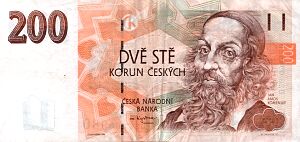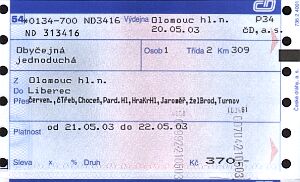Prologue
I guess I was only 10 years old or so when I traveled (or better: joined my parents) to the Czech Republic - at that time still Czechoslovkia. And I traveled there again and again - before the Czech Republic and Slovakia split. While they were splitting. And after they split. I'm sure that my visits count up to some 30 times. I can't say that I got enough - I love the country, the people, the food, the towns, the landscape and - I admit - the beer. Traveling to the Czech Republic is like visiting an old friend - who has changed a lot over the years but not necessarily to the worse. Although one place has definitely changed to the worse - Prague. A city I started to avoid, because it's got very, very touristy. Though still a must-see, I can only recommend to everyone to visit more than just the capital - it's well worth the effort.
Entry & Visa
Since prices in the Czech Republic are considerably lower than in neighbouring Austria and Germany, it's quite popular to hop over to border-near cities to do some shopping. Customs knew about that and so border controls, esp. when going by car, could be fierce and time-consuming. This changed after joining the EU - customs search at checkpoints was abandoned. Be aware that the former import- and export regulations are still valid and mobile customs officers operating in the hinterland may check you. Most EU-citizens, Americans and Japanese do not need a visa. Unfortunately, Aussies and Kiwis still need a visa, which cannot be obtained upon entry. The Czech republic has not joined the Schengen treaty yet (there are no more border controls between all countries signing the treaty), which means that passports will be checked upon arrival. There are countless border checkpoints between the Czech republic and →Poland, Austria, →Slovakia and Germany. Along hiking routes, some of them are unguarded.
Money
Czech Crowns. The official Czech name is Koruna Českých, the short form 'Koruna'. The national abbrevation is Kč, the international abbrevation is CZK. One Crown is 100 Haleru.

| ||
| Czech 200-Crown bill |
There are 50, 100, 500, 1000, 2000 and 5000 Crown bills. Naturally, it's often difficult to use bigger bills in small restaurants, kiosks etc. There's also a 20 Crown bill, but they are mostly replaced with coins. Circulating coins include the 10, 20 and 50 Haleru as well as 1, 2, 5, 10, 20 and 50 Crowns. The latter is quite rare and a beautiful two-coloured coin. Inflation rate is quite low and so the rate between euro and other strong currencies and the Czech Crown is rather stable. During the last years, rate was around 1 € = 31 Kč ±2.
Money Exchange
It's better to avoid the exchange booths in Prague's train stations. Either the exchange rate is bad or the fee is too expensive. Better walk a few hundred meters or stick to cash or credit cards. All common credit cards and EC-cards resp. Maestro-Cards are widely accepted and can be used with all ATM's. Holes in the wall can be found everywhere.
The usual fee for a transaction is 2% but at least € 4, depending on the bank. In general it can be said that rates at the bank are much better than rates at exchange booths. Attention: Especially in Prague scam is quite common. The usual one is a man or woman offering a much better exchange rate. But the Czech currency is convertible, so there's nothing like a black market. Do not change money on the street! In areas near the the Austrian and German border, the euro is widely accepted in restaurants and supermarkets.
Costs
Budget travellers can get on with around € 20 a day, providing that demands on accomodation and food are not too high. In Prague it's almost impossible - entrance fees etc. included, first time visitors will easily spend € 50 or more per day.
By plane
There are connections to most major cities within Europe. However, as far as I know there's no transcontinental flight. When coming from Australia, Asia America or Africa, it might be necessary to go via one of the major European airports, i.e. London Heathrow, Paris CDG, Frankfurt or Vienna. Most international flights are bound for →Prague Int'l Airport.
By train
Numerous local trains and express trains cross the border. The daily Pannonia-Express starts in Berlin and ends in →Budapest. The train goes via Dresden, →Prague, →Brno and Bratislava (capital of →Slovakia). Furthermore, there are express trains to →Warsaw in →Poland, →Bucharest, →Varna (Bulgaria), Vienna and many more.

| ||
| Czech train ticket |
For all travellers entering the country from Germany: To the capital →Prague, it takes 4½ hours from Berlin (direct), 7½ hrs from Hamburg (same train, direct), 7 hrs from Frankfurt (via Dresden) or 8½ hrs with a direct night train, Munich 9 hrs (night train) or 6½ hrs via Nuremberg and less than 2½ hrs from Dresden. As for the ticket price - it's cheaper to buy a return ticket in Germany as there are discount fares.
Probably the cheapest way from Germany is the so-called 'Schönes-Wochenende-Ticket' (Nice weekend ticket - for € 40 or so up to 5 people can travel freely on all local trains during the weekend). A local train called Vogtlandbahn goes from Plauen via the Czech city →Cheb to Marktredwitz in Northern Bavaria. The above-mentioned ticket is valid. From Cheb, it's possible to go ahead with the much cheaper Czech train fares.
By car
As already mentioned, there are many border checkpoints. Although customs check had been abolished, it might take a while to cross the border, depending on the day of the week, and the time of the day. Especially on German bank holidays many cars will queue at the border.
Czech rail and road network is excellent and it's no problem to move around at will. Almost all major streets are in very good condition and trains will take you to the smallest cities. Some details:
By plane
There are a few national flights, but the Czech Republic is not very big and so connections are limited. The most important connection is from →Prague to →Brno. For travellers, this connection should be irrelevant - the train is much cheaper and only takes 3 hrs.
By train
| Important vocabulary for train rides | |
|---|---|
| ticket | jîzdenka |
| from...to...via | z...do...přes |
| group discount | sleva pro skupiny |
| single ticket | jednoduchá |
| return ticket | zpáteční |
| persons | osob |
| class (1,2) | třída |
The Czech railway company is called České Dráhy (ČD). As far as I know, railway system hasn't been privatised yet and offers an extensive network connecting almost all cities. Trains are usually spotless clean. Main hub by all means is →Prague, which means that it's no problem at all to get to Prague from almost every place. However, getting from A to B without passing the capital can be very time-consuming. Thus, it is a good idea to compare bus to train connections when moving between smaller cities, since busses are sometimes faster and more frequent.
There are no bullet trains or any other ultra-fast trains. The fastest train is the international EC (Eurocity). Note that these trains are considerably more expensive. Most trains are either R (rapid trains) or Os (regional trains). The latter often consist of one carriage only and run on short distances. Full trains are seldom, but some can be packed depending on the time of the day and the day itself. Some long-distance trains have a restaurant.
The Czech word for 'main station' is Hlavní Nadraží (abbr. Hl. n.). This is important to know, since the main station is quite far away from the city centre in some Czech cities.
The Czech railway company offers substantial discounts when purchasing return tickets and/or group tickets. The discounts do not seem to add up. The regular price seems to be around 1.2 bis 1.3 Kč per kilometer (= € 4 for 100 km).
When buying a return ticket, the fare is around 0.7 Kč/km. Travelling alone is the most expensive option. One or two more persons, and the fare is as low as 0.6 to 0.7 Kč/km (i.e. € 2 for 100 km). Given prices are for 2nd class without reservation and subject to change. By the way, almost all national trains are completely non-smoking.
By car
General quality of Czech roads is quite good. There are a few motorways, mainly around →Prague, but all motorways are toll-roads. However, there are no toll stations. When using a motorway, it's necessary to stop at the first petrol station and purchase a toll badge to be sticked on the windscreen. The toll is not very expensive. There are two different types - one is for 10 days, the other one for one year. Getting caught without the badge is rather expensive - the fee is 5000 CZK (almost € 170).
©2024 Europe-East.com

 Albania
Albania Czech Republic
Czech Republic